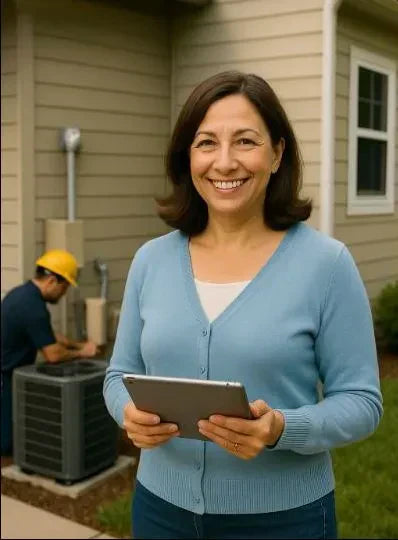Maintenance Checklist for Your R-32 AC + Air Handler
Why Maintenance is the Secret Ingredient
Buying an R-32 AC system is a smart step—better efficiency, greener refrigerant, and future-ready technology. But here’s a truth many homeowners overlook: performance doesn’t stop at installation. Just like a car needs oil changes, your R-32 AC and air handler need regular care to run efficiently.
Neglecting maintenance can cut system efficiency by 10–20%, shorten lifespan, and increase operating costs. With a little routine attention, you can extend your investment for years while keeping energy bills in check.
This guide gives you a step-by-step maintenance checklist, blending DIY tasks with the jobs best left to professionals.
Step 1: Replace or Clean Air Filters Regularly
Why It Matters
Your air handler filter traps dust, allergens, and debris. A clogged filter:
-
Reduces airflow
-
Increases energy consumption
-
Forces your system to work harder
ASHRAE research found that dirty filters increase HVAC energy use by 15% or more (ASHRAE – Filtration Standards).
Checklist
-
Inspect monthly during peak season.
-
Replace every 1–3 months (or wash reusable filters).
-
Choose high-MERV filters for better air quality.
Step 2: Keep Coils Clean
Why It Matters
The evaporator coil inside your air handler and the condenser coil outdoors are where the magic happens. Dust and grime on coils act like a blanket, reducing heat transfer.
A Building and Environment study showed that fouled coils can reduce cooling capacity by up to 30% (ScienceDirect – Building and Environment).
Checklist
-
Gently vacuum indoor coils during seasonal checks.
-
Clear debris (leaves, dirt) around outdoor coils.
-
Schedule professional coil cleaning annually.
Step 3: Check Drain Lines and Pans
Why It Matters
Air conditioners remove humidity, which drains away through a condensate line. Clogs cause leaks, water damage, or mold.
The Journal of Building Engineering highlights how moisture mismanagement in HVAC systems contributes to mold growth indoors (ScienceDirect – Journal of Building Engineering).
Checklist
-
Inspect drain pans for standing water.
-
Flush the drain line with vinegar every few months.
-
Ask a pro to check during seasonal tune-ups.
Step 4: Inspect and Seal Ductwork
Why It Matters
Even the most efficient R-32 system will waste energy if ducts are leaky. The EPA estimates that duct leakage can waste up to 30% of conditioned air (EPA – Indoor Air Quality).
Checklist
-
Visually inspect for disconnected or crushed ducts.
-
Seal joints with mastic or UL-rated foil tape.
-
Schedule duct pressure testing every few years.
Step 5: Monitor Refrigerant Levels
Why It Matters
R-32 refrigerant is efficient but requires precise charge levels. Low refrigerant = poor cooling, frozen coils, or compressor failure.
A Nature Energy study found that undetected refrigerant leaks increase lifetime system emissions and energy use (Nature Energy).
Checklist
-
Watch for warning signs: warm air, hissing noises, ice buildup.
-
Call a licensed tech for leak detection and recharge.
-
Never DIY refrigerant handling—R-32 requires certified professionals.
Step 6: Test Electrical Connections
Why It Matters
Loose or corroded connections strain motors and compressors. Over time, this reduces lifespan and increases fire risk.
Research in the International Journal of Electrical Power & Energy Systems confirms that poor electrical maintenance leads to premature HVAC failure (ScienceDirect – IJEPES).
Checklist
-
Have a pro tighten electrical connections annually.
-
Inspect breakers and fuses.
-
Consider surge protection for variable-speed R-32 systems.
Step 7: Seasonal Professional Tune-Ups
Why It Matters
While DIY goes a long way, pros catch issues homeowners miss. Annual maintenance can extend equipment life and improve reliability.
A Lawrence Berkeley National Lab review found that proper maintenance reduces household HVAC energy use by 10–20% (LBNL – Energy Efficiency Study).
Checklist
-
Schedule spring tune-ups for the cooling season.
-
Schedule fall tune-ups if your system provides heating.
-
Request full documentation of refrigerant, airflow, and test results.
Bonus: Smart Monitoring
Modern R-32 systems often integrate with smart thermostats or apps. Use these features to:
-
Track run times
-
Spot efficiency dips early
-
Get reminders for filter changes and tune-ups
Common Maintenance Myths
-
“I don’t need maintenance for new equipment.” Wrong—skip it, and you’ll void warranties.
-
“Filter changes are enough.” They help, but coils, drains, and ducts also need care.
-
“I’ll call a tech only if it breaks.” By then, damage (and repair costs) may be much higher.
Protect Your R-32 Investment
Your R-32 AC and air handler are designed to be efficient, eco-friendly, and reliable. But they need regular attention to deliver on those promises.
By following this checklist, you’ll:
-
Keep bills lower
-
Improve comfort and air quality
-
Extend system lifespan
-
Protect your warranty
In short: maintenance isn’t just a chore—it’s the secret ingredient to long-lasting comfort.







